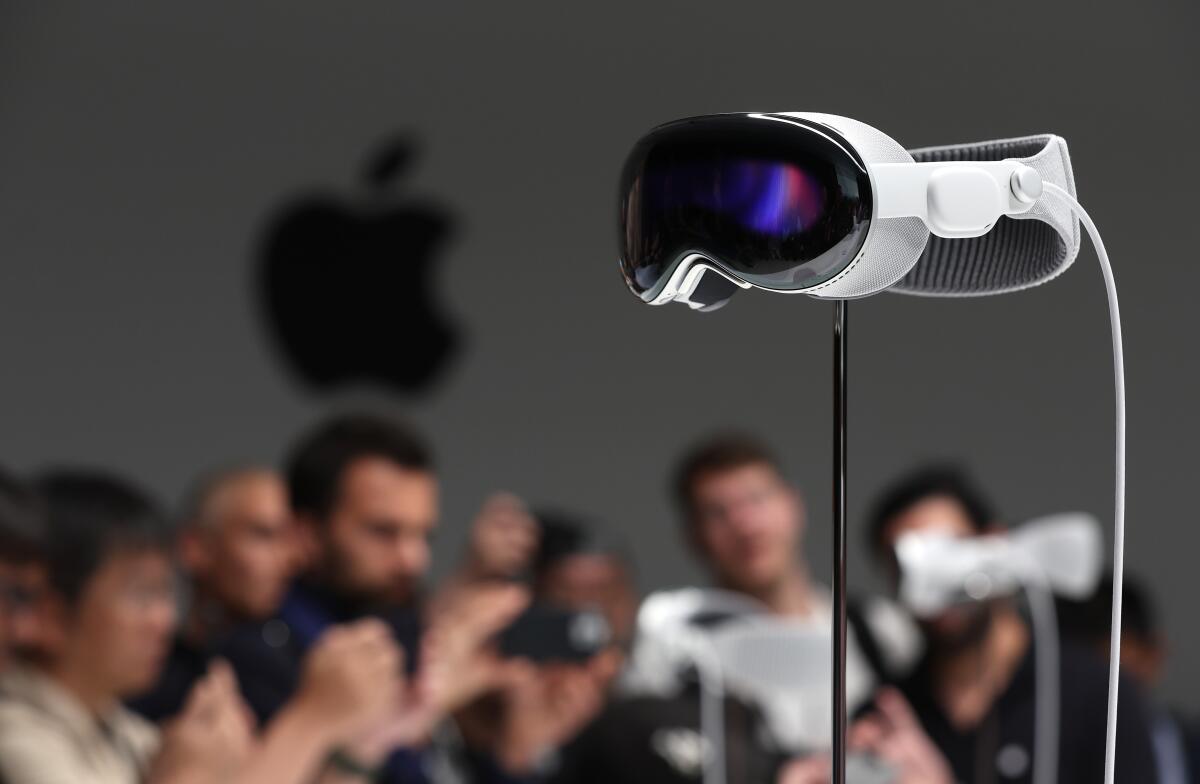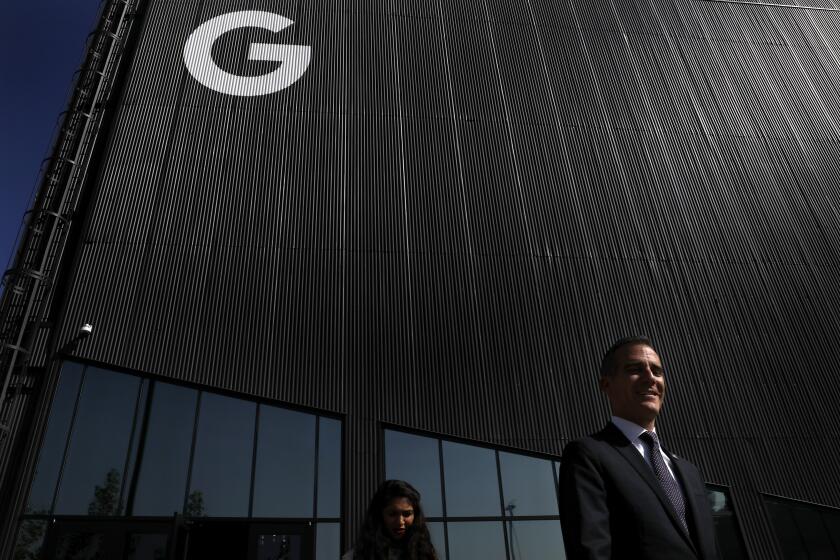Column: Forget the metaverse. For $3,500, Apple offers a new way to be alone

- Share via
Remember the metaverse? No? Well, you’re not alone.
It seems but a faint memory now, but before AI mania swept Silicon Valley, the concept that everyone would soon be strapping on headsets and logging on to an “embodied internet” to do conference calls and standup comedy was center stage in the tech world — thrust there by Facebook founder Mark Zuckerberg.
Yet even at the peak of its hype cycle, polls found that most Americans had never even heard the term “metaverse.” It didn’t take.
To Apple, that’s just as well, seeing as how it now aims to wipe the metaverse away completely. This week, the most giant tech giant announced the Vision Pro, a $3,500 “spatial reality” headset, its first major new product in half a decade. That’s an absurdly hefty price tag — attendees at Apple’s developer conference groaned aloud when the cost was read — and still something of a big deal, seeing as how the fruit company rarely wades into a new arena unless it’s serious about doing battle.
Apple’s pitch? This may be virtual reality, but it’s anything but the metaverse. This is brand new technology for you, the consumer, to be enjoyed inside Apple’s famous walled garden. Its demo was all about watching huge virtual movie screens in your living room and disappearing in beautiful simulated natural environments. It’s a high-tech home theater for your face. Unlike other headsets, there are no handheld controllers — you navigate the digital world by looking at the objects of interest and pinching your fingers. You are immersed, you are entertained, and you are very much alone.
In fact, you could call Apple’s foray into headset computing the anti-metaverse — for better and for worse.
Not only did neither Apple Chief Executive Tim Cook nor any of the other executives ever utter the term “metaverse,” their vision of how headset-based computing will succeed was anathema to Zuckerberg’s dream of a connected digital world filled with 3-D avatars, games and co-working.
This shouldn’t come as a shock, seeing as how spectacularly and completely Facebook’s metaverse ambitions have crashed and burned.
After Uber and other gig giants failed to pay a mandated rate hike, two eagle-eyed drivers started asking questions — and won a jackpot for California gig workers.
Now, in theory, one can see the industry appeal of the metaverse; why Zuckerberg was so taken by the idea, and why, in what will go down as one of the all-time ‘putting the cart before the horse’ tales in the annals of tech, he renamed his world-historically profitable company Meta and dedicated tens of billions of dollars to making it a reality.
It’s a little fuzzy now, but the metaverse’s key promise was that we wouldn’t browse the web; we’d experience it. And that we’d experience it with other denizens of the metaverse — virtual officemates, professional duelists, and friends and family were always just an augmented hallway away. Facebook’s launch demo was so scattershot that when it was over, no one was quite sure how it was all even supposed to work.
Which perhaps explains why it didn’t. In fact, the circus left town before anyone could even stake down the tent. No one really showed up to Meta’s chief metaverse attractions, despite the relentless hyping by Zuckerberg and venture capital evangelists, and digital ghost towns were left in their stead.
Companies that had rushed to appoint chief metaverse officers in 2021 had quietly dissolved the divisions by 2023. After all the relentless promotion and tens of billions of dollars invested, only 1 in 5 Americans could even correctly identify the term. Another poll found that, of those who knew what it was, many more were afraid of what it portended for society than were excited by it. No amount of weird 2000s-style Wii graphics featuring Zuckerberg and the Eiffel Tower could change that, it turned out.
Which brings us back to Apple. Why would the undisputed king of the hardware space want to wade into this territory at all?
It can’t just be about sunk costs — Apple has killed costly internal projects before, rather than ship an unpopular and potentially unsuccessful product. Apple must genuinely believe that there’s a future in headset computing, and that it looks nothing like the failed fantasies of the metaverse thus far.
I put the question to David Karpf, a professor of media and public affairs at George Washington University and the author of a newsletter called The Future, Now and Then, who has paid special attention to the development of headset technologies.
“I’m of two minds about this headset,” he told me. “In the near-term, I think it won’t do any better than the Oculus/Meta Quest. There simply isn’t much to do with Apple’s Goggles, and at $3,500 not a lot of people are going to buy it just to tinker around.” And yet, although he expects the Vision Pro to flop initially, he thinks its technical breakthroughs might matter a decade from now.
Reviews of the Vision Pro have echoed precisely this point — they’ve been positive on the specs, but mixed on the application. The Verge’s Nilay Patel praised the next-level resolution and computing power, the seamlessness of the experience — but still asked what it might all be for. “The most perfect headset demo reel of all time is still just a headset demo reel,” he wrote.
Increasingly offering products untethered to the average consumer’s needs, the tech industry has been dwelling in La La Land. Its real-world expansion into L.A. is no coincidence.
The question very much remains: What will most people actually want to do with a virtual reality headset?
For Meta, there was at least one answer: Play games. Gaming remains the key driver for VR technology, and really, the only widely proven use case thus far. Millions of users play games such as “Beat Saber” and “No Man’s Sky” — that’s millions more than hang out on Meta’s Horizon rooms.
Gaming was, incidentally, probably what made Zuckerberg think the metaverse might work: “Roblox,” “Fortnite” and “Second Life” are basically 2-D metaverses. And gaming is the only thing that keeps Meta’s virtual reality ambitions from unraveling completely. Notably, gaming is social, or at least parasocial.
But by shipping without controllers, Apple is all but admitting it’s not interested in tackling that market. It’s all about watching movies, doing meditation apps, and working your design job in augmented reality. In easily its least appealing feature, users can FaceTime with uncanny valley avatars of users’ faces — that’s really the only time users get out of Apple’s spatial enclosure. There might be some captivating and fascinating programs, but you will be experiencing them by yourself, on Apple’s terms alone.
These are two very different visions for the future of headset computing; in fact they’re almost polar opposites. Meta’s ambition was for a wild, interconnected world where, in theory, other tech companies would build metaverse spaces that bisected its own. It was to be a digital alternate reality, a world of endless possibilities.
The problem was that few believed even for a second that Facebook, the company famous for harvesting your personal data to sell to advertisers and letting toxic misinformation run rampant on its platform, would be in any position to steward such a world into existence. The vision was curdled right out the gate, and the bad graphics and embarrassing demos only helped speed its demise.

Apple’s approach seems to be a more restrained one — bridging the gap between iPhone and spatial reality with familiar apps and gesture interactions. Still, I don’t know about you, but when I watch the first Vision Pro commercial, of people in planes, living rooms, in the kitchen with their children, disappearing into a totally immersive computer on their face — one whose content we know, because it’s Apple, will be strictly vetted and controlled — it depresses me.
We might venture a guess at what Apple’s anti-metaverse will look like by taking out our phones right now, looking at our apps, and imagine physically existing among them. For Disney+ that might be fun, for a while, and ditto with your photos and movies. Just about everything else, I’m about close enough to already, thanks. In fact — and I can’t imagine I’m the only one — I’d rather not disappear any further into my phone.
That these kinds of immersive digital worlds, whether closed or open, would rise to prominence was always a dystopian idea, one that originated in cyberpunk fiction, premised on the notion that conditions in the real world were so bad that users had to abandon their actual lives completely and escape into a more poorly rendered simulacrum.
This is precisely why Karpf thinks that “computers-on-your-face” might have a future after all. “If the world keeps getting worse,” he says, “this will eventually have a lot of appeal.”
If Apple’s vision wins out, the fear is that we’ll all sink into our cypberpunk home theater goggles, consuming content as the world burns — it’s almost enough to make you wish for the metaverse.
- Share via
Watch L.A. Times Today at 7 p.m. on Spectrum News 1 on Channel 1 or live stream on the Spectrum News App. Palos Verdes Peninsula and Orange County viewers can watch on Cox Systems on channel 99.










